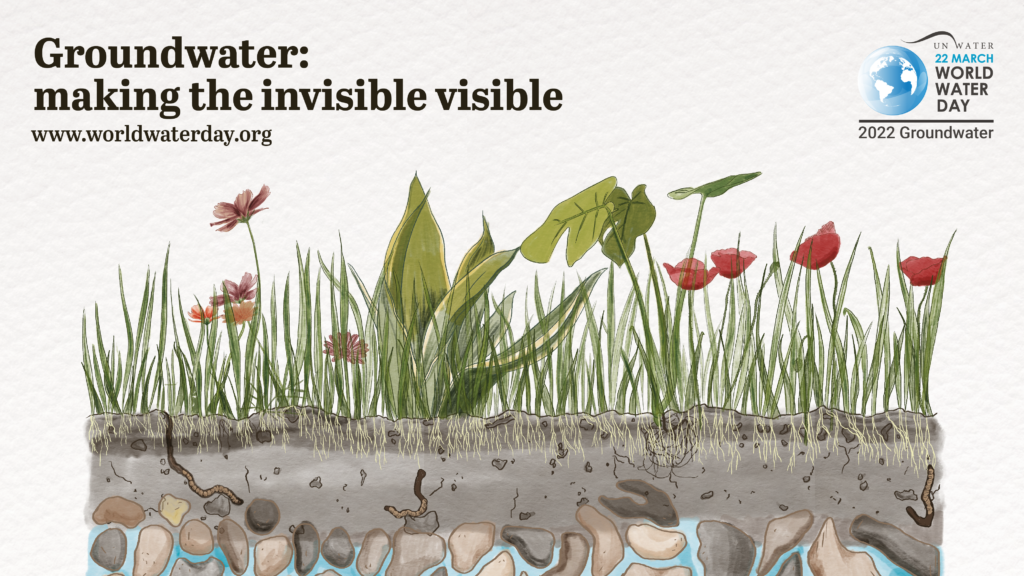
For this 2022 World Water Day, HR2W hosted a discussion on groundwater and human rights to fit with the World Water Development Report annual theme. In order to bring attention to the importance of this matter, we have an introductory presentation from David R.Boyd, the Special Rapporteur on the Human Right to a Healthy Environment, followed by a short discussion with experts on groundwater and human rights to water and the environment.
David Boyd introduced the discussion with his statement that “Groundwater is like a hidden treasure that provides safe drinking water for billions of people around the world”. He continues to explain that it is under pressure from excessive use, pollution, toxic contamination and climate change. The rights based approach can be a catalyst for change in the improvement of this situation. It will help us to focus on increasing our knowledge on groundwater, ensure full and inclusive participation, provide monitoring of quality and quantity with limits on extraction, and enable discussions about allocations of water, giving priority to the human rights to water, and other human rights to food and a healthy environment.
To follow, Amanda Loeffen, CEO of Human Right 2 Water, met with Jenny Gronwall (SIWI) and Kerstin Danert (Ask for Water). Jenny is known for her expertise on groundwater and also as the SIWI focal point on the human rights-based approach. Jenny and Kerstin have co-published a report on how groundwater supply forms an essential mode for governments to enable achievement of SDG6 and provide access to water for all people.
Groundwater provides half of all water for domestic use and accounts for around 99% of all liquid freshwater on Earth, but it is invisible to us and though the quality of the raw water is often much better than is the case for surface water, we need to better understand the needs to protect it from pollution and over-abstraction, in order to safeguard the health of humankind and ecosystems in the long run.
Jenny Gronwall described how groundwater is different from surface water in that it is often accessed by households and communities themselves, through self-supply and own investments in digging wells or investing in drilling to reach it. But for the most part, those end-users are not aware of how, for instance, the water cycle and climate change impacts on the resource base they depend on. Such insights are crucial to translate into management decisions when we talk about increased provision of safe drinking water for local communities. Aquifers are gradually deteriorating with lower levels, higher concentration of contamination, and this impacts the quality and quantity of water for people in rural communities that have no other source of drinking water.
Kirsten Danert started by emphasising the essential role that groundwater plays in reaching the SDG goal 6.1. The discussion turned to setting standards and regulations for drilling and boring water, an area where she is an expert. There is a clear need for protection of groundwater from contamination, and then there is the important matter of mapping and measuring aquifer use, so that there is sufficient water available for future generations of people to access drinking water. Currently, there are no limitations in some countries for extracting large volumes of water for agricultural or commercial use, often at the expense of people’s human right to water. This is especially important in areas where people do not have other sources of water for drinking other than groundwater.
Groundwater is going to play an even greater role in the future, particularly with climate change, and the increased risk of extreme weather events such as floods and droughts. Protected groundwater supplies, such as protected springs, wells, and boreholes are also a major part of the solution for many of the world’s population that are currently using surface water, or unprotected groundwater. There is an urgent need to focus on the communities and households that have been left behind with respect to drinking water supplies that are accessible, reliable, affordable, safe and easy to manage. We need to identify who is being left behind, and understand why.
Finally, Amanda emphasised that the human rights based approach is part of the answer to the design and implementation of water use, as introduced by David. If representatives of all stakeholders from the local community, including vulnerable groups, are able to participate in decisions about how the water is used and distributed, and there is accountability by local authorities through standards and regulations as a result, then there is far more likelihood that the end result will be a sustainable system that protects, respects and fufils the human rights to a healthy environment, to food and the human rights to clean and safe drinking water for all.




